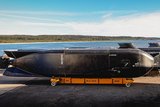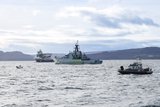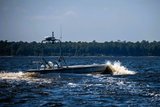EDA study confirms laser technology benefits
A study commissioned by the European Defence Agency (EDA) has confirmed the benefits of using laser-based technologies for the detection and identification of underwater targets, EDA announced on 20 July.
The study was conducted by a consortium consisting of the Swedish Defence research Agency and the French-German Research Institute of Saint-Louis.
The study highlighted the use of laser systems – both Light Detection and Ranging (LIDAR)-based, and Laser Detection and Ranging (LADAR)-based – and found that their integration into existing detection and identification technologies for underwater targets in difficult operating conditions can have a significant and positive impact on performance, particularly for rapid detection and identification.
Laser systems can deliver operational improvements compared to sonar systems; for example airborne laser scanning can be deployed extremely quickly in order to detect, locate and track underwater or floating objects. It is also possible for airborne laser scanning to identify the types of targets, provided that the target is large enough.
Once a target is detected it is then possible to quickly deploy a surface or underwater vessel equipped with a Laser Gated Viewing or Underwater Laser Scanning system to positively identify confirm the target information.
According to the EDA, the study concluded that laser-based technologies are a viable and complementary solution for acoustic sensor systems, even in turbid waters or in waters with high organic content, such as shallow regions or archipelagos found in the Baltic Sea.
More from Naval Warfare
-
![How the Anduril-HHI autonomous ship plan fits in with the US Navy’s MASC programme]()
How the Anduril-HHI autonomous ship plan fits in with the US Navy’s MASC programme
The new modular vessel is expected to be developed for both commercial and defence use, with a heavy focus on production speed and mission flexibility.
-
![Indo Pacific 2025: Autonomous systems reigned but can the Australian Defence Force afford it?]()
Indo Pacific 2025: Autonomous systems reigned but can the Australian Defence Force afford it?
Multiple autonomous systems and technologies were on display at this year’s Indo Pacific, but questions remain over how the Australian Department of Defence will balance the books.
-
![How the UK Royal Navy is powering up its hybrid fleet to combat new threats]()
How the UK Royal Navy is powering up its hybrid fleet to combat new threats
Since it announced its move towards a new “hybrid navy” earlier this year, the force has announced a number of new uncrewed technologies in the works.
-
![US and UK to begin Trident II D5 Increment 8 in October 2026]()
US and UK to begin Trident II D5 Increment 8 in October 2026
Trident II D5 Increment 8 will involve improvements to the shipboard navigation subsystem for the US Ohio and Columbia and the UK Dreadnought and Vanguard submarine classes.
-
![US Navy starts acquisition process for uncrewed maritime systems for support missions]()
US Navy starts acquisition process for uncrewed maritime systems for support missions
The USN is interested in uncrewed capabilities that can carry out explosive ordnance disposal, mine countermeasures, force protection, ISR and anti-submarine missions.






















